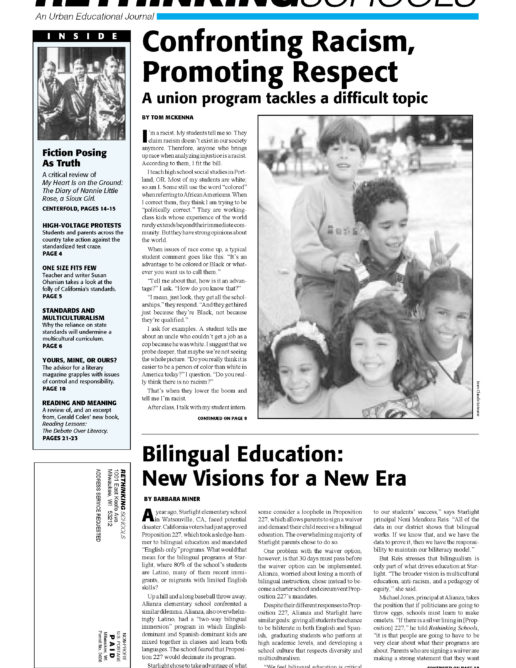Preview of Article:
Bilingual Education: New Visions for a New Era
How might a new vision of bilingual education manifest itself in the classroom, where, like all reforms, it will either succeed or fail? Starlight and Alianza provide clues.
Starlight, which is nine years old, first had a bilingual program that Reis called “early-exit.” Under this model, students began kindergarten speaking Spanish but were expected to move into English-only programs by third grade. Spanish was dropped completely at that point. There were two big problems: the kids didn’t have sufficient English skills by third grade to be able to keep up academically, and they were unable to maintain their skills in Spanish and become truly bilingual.
The school then shifted to a “late-exit” model, especially after Starlight’s district found that kids who had been in Spanish bilingual programs longer were doing better in high school. Both the “early-exit” and “late-exit” models were founded on what is often called a “transitional” model — which means that the main goal is to “transition” kids into English-only classes, often with little regard for maintaining their first language. The overwhelming bulk of bilingual programs in this country are transitional, even though research has shown that the best bilingual programs also develop and maintain a child’s first language.
This year, Starlight moved to what it calls a “biliteracy” model — a word somewhat alien to parents but increasingly common among educators who want to emphasize that true bilingualism involves not just speaking in two languages but also reading and writing. Reis said the “biliteracy” approach also offers a way to more formally introduce English and to counter criticisms that bilingual programs teach too much in Spanish at the expense of English.
Reis said Starlight was able to adopt “biliteracy” in the face of Proposition 227 because of the support in the district for bilingual education. The superintendent took the stance that “diversity and multilingualism are a plus for our city, which was courageous in light of 227.” Under district policy, schools must have a specific model to offer parents who sign a waiver to continue in bilingual education. The district models offered are dual-immersion or biliteracy, both of which emphasize becoming proficient in both English and Spanish.</p

